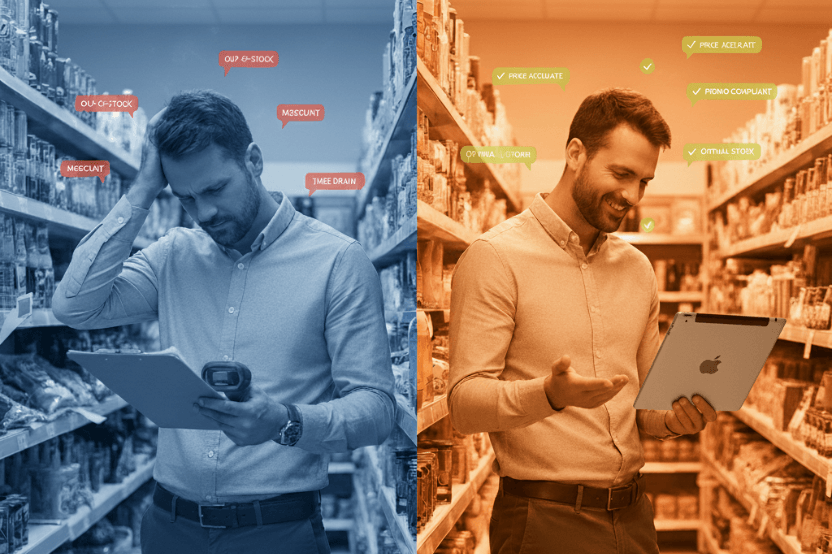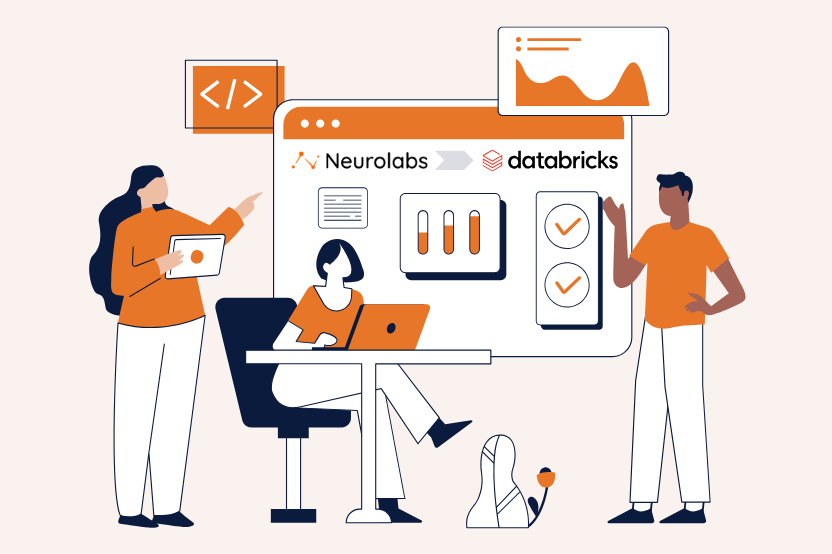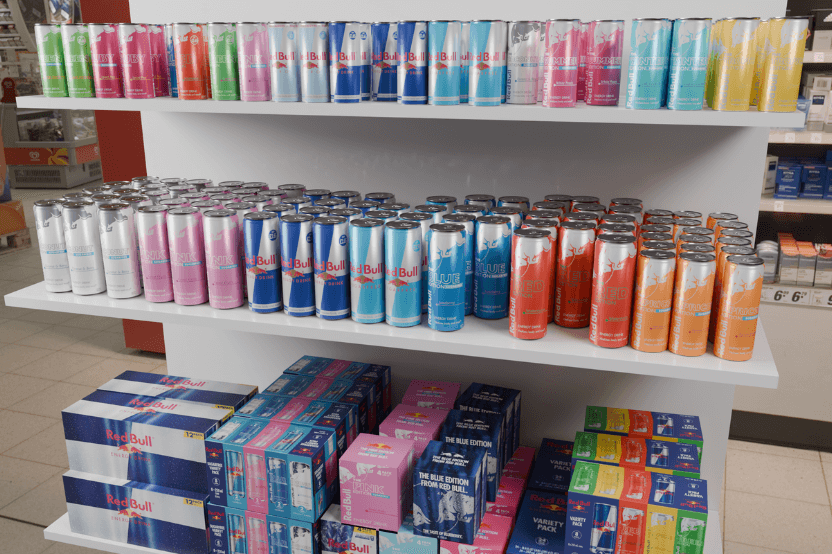Walking through the buzzing halls of NACS 2025 in Chicago, it was impossible not to feel both the excitement and the pressure running through the consumer goods industry. Every booth, every conversation, seemed to circle back to a single, uncomfortable truth:
We still don’t see clearly enough what’s happening at the shelf and when we do, it’s often too late to act.
At Neurolabs, we’ve always believed that visibility drives value. But what I saw and heard at NACS this year reinforced something very specific: the biggest blockers to better commercial performance in convenience are still the execution visibility gap and data lag. Until those are solved, everything else, trade optimisation, RGM, retail media, is built on shaky ground.
1. C-Stores Are Big, Fast-Moving and Still Execution-Driven
One thing NACS 2025 made very clear: convenience is a channel nobody can ignore.
C-stores account for roughly 16% of U.S. CPG sales, yet for many brands they’re still “less than 20%” of total revenue. They’re not the biggest piece of the P&L, but they punch well above their weight in terms of growth, visibility and competitive pressure.
The categories that dominate c-stores, energy drinks, beer, soft drinks, confectionery, snacks, are exactly where:
- Resets are frequent
- Cold boxes and transaction zones matter more than traditional aisles
- Secondary placements (like under-counter displays) can drive +25–30% uplift when executed correctly
It’s an incredibly execution-driven environment. The brands that win here are usually not the ones with the best strategy on paper but the ones that can see, correct and capture opportunities fastest at store level.
And that’s where the cracks really showed.
2. The Execution Visibility Gap Is Still Huge
If I had to summarise the main operational challenge I heard at NACS in one phrase, it would be:
“We think we know what should be happening on the shelf. We rarely know what is happening.”
Across conversations with manufacturers, distributors and brokers, the same issues came up:
- Planogram non-compliance is persistent, not occasional
- Chains that “should have 5 items” routinely have 3 actually stocked
- Competitors can convince store managers to flip sets locally with little or no HQ visibility
- Brands only discover issues when volumes drop or someone flags a problem manually
Most companies are already capturing before/after photos as part of store visits. The images exist. But in many cases, those photos don’t translate into systematic, timely insight.
The result? An execution gap that everyone feels, but very few can quantify with confidence.
At Neurolabs, this is exactly where we see visual AI playing its first, most immediate role:
turning the photos you already collect into structured shelf data you can actually act on and at scale.
3. Data Lag Is Turning Decisions Reactive, Not Proactive
The other major theme was data latency.
Traditional sources, syndicated data, shipment data, POS reports, distributor feeds, often come in with delays of up to four weeks, sometimes longer. On top of that, many brands are stitching together three or four different datasets just to get something resembling a complete view.
I heard variations of the same story:
- Teams merge Nielsen / Circana / IRI / MSA to build a “good enough” picture
- Net tracking combines shipments with sales to guess where voids might be
- 90-day reorder thresholds are used as proxies for availability gaps
It’s clever, but it’s still backward-looking. By the time the picture is clear enough, the opportunity has passed or the issue has already cost real money.
What people wanted, and were very open about, was a faster photo → insight loop. Not more dashboards, not more KPIs, but the ability to see what changed in a store this week and then intervene while promotions, displays and negotiations are still live.
That’s why “real-time” came up so often at NACS. Not as a buzzword, but as an antidote to a very real lag problem.
4. Field Teams Are Stretched Between Data Entry and Selling
If you map all of this back to the field, it becomes even more obvious how much is being asked of frontline teams.
The scale alone is huge:
- Major confectionery and snack brands running 600+ field reps
- Tobacco companies deploying 1,000+ reps nationally
- Smaller, fast-growth brands working with lean teams of 12–50 people
And yet, across that spectrum, the same pattern emerged:
- Reps spending 25-30 minutes per store on manual logging and data entry
- Multiple apps, forms and portals to update
- A strong feeling of “this is just another thing I have to do” whenever new tools are introduced
Field teams know execution matters. They see the issues first. But they’re often operating in workflows where capturing the reality of the shelf costs time they’d rather spend selling, influencing or building relationships.
For me, this is where technology has to be honest: If we’re asking reps to capture photos or additional information, we have to give more back than we take away — in time saved, friction removed or commercial impact.
At Neurolabs, we’re very focused on this. Visual AI only works if it’s embedded into existing field flows, not bolted on as yet another task.
5. Compliance, Contracts and ROI: More Than Box-Ticking
NACS also brought into focus how compliance and visibility are directly tied to money changing hands.
In categories like tobacco and beverages, we saw examples where:
- Customer payments depend on verified execution compliance
- Contracts are structured around placement, presence and promo execution
- Distributors and customers are paid per unit sold only if the right execution is in place
In confectionery and snacks, the focus is shifting to transaction zones and secondary displays because two-thirds of shoppers may never walk the candy aisle at all. In that context, visibility isn’t a “nice to have”, it underpins:
- Whether contractual obligations are met
- Whether brands can trust invoices and trade spend
- Whether secondary placements are actually delivering the +25–30% uplifts that justify them
The more we spoke about audits, the clearer it became:
Audit data is no longer just about compliance; it’s about commercial validation.
That’s where visual shelf data naturally starts to feed into revenue management, trade optimisation and even retail media. But only if it’s accurate, timely and trusted.
6. A Market in Transition and Where Visual AI Fits
If you zoom out from all these conversations, the picture that emerges is not one of a fully connected, fully optimised ecosystem. It’s a market very much in transition:
- C-stores are large and strategically important, but still under-instrumented
- Execution gaps are persistent and often invisible until they hurt
- Data is fragmented and late, forcing teams into reactive decision-making
- Field teams are time-poor and wary of yet another tool
- Budgets are there, but ROI narratives need to be very clear
This is exactly the world Neurolabs is building for. Our view is simple:
- The photos already being captured should create a live, objective view of the shelf
- Field reps should spend less time typing and more time selling
- Execution data should flow into the same environments where RGM, TPM and commercial decisions are already made
Synthetic data and digital twins are part of how we deliver on this, enabling faster, more scalable image recognition without waiting months for training photos but that’s our solution to the problem, not the lesson from NACS itself.
The lesson from NACS is this:
Until the visibility gap and data lag are solved, CPGs will always be partially flying blind in one of their most execution-driven channels.
Key Takeaways from NACS 2025
Here’s what stood out most from this year’s conversations and sessions:
- Shelf visibility remains patchy. Planogram and promo compliance issues are widespread and often invisible to HQ until something breaks.
- Data latency is a real, structural problem. Traditional data sources run weeks behind; teams are merging 3–4 datasets just to see what happened.
- Field reps are overburdened. Too much time is spent on data entry, not enough on selling and influencing execution.
- Compliance is commercial. Execution now underpins contracts, payments and ROI, especially in categories like tobacco, beverages and confectionery.
- C-stores are a high-leverage channel. Energy drinks, beer, soft drinks and snacks make convenience a critical battleground, even if it’s not the largest revenue share.
- Technology has to meet people where they are. Tools that embed into existing flows and clearly save time are far more likely to be adopted.
Looking Ahead
Leaving NACS 2025, one thing was clear: the next era of CPG retail execution won’t be defined by who has the most data, but by who can see the shelf clearly, fast enough to act and with enough confidence to link execution to ROI.
At Neurolabs, our mission has always been to help brands see, understand and act on what’s happening in-store, in real time. The conversations in Chicago only reinforced how urgent and relevant that mission has become, especially in a channel as dynamic and unforgiving as convenience.
The road ahead for CPGs is full of opportunity, but it will reward the agile, the connected and the curious. For those willing to rethink how they see the shelf, the next few years will be transformative.
Want To Continue the Conversation?
If you’d like to explore how visual AI can help close your execution visibility gap and reduce data lag, we’d be happy to show you what’s possible.
You can book a demo with Neurolabs or connect with me directly on LinkedIn, I’m always keen to exchange ideas with leaders pushing the industry forward.
Remus Pop
Co-Founder & CRO




